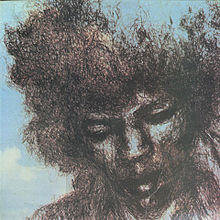- The Cry of Love
-
"Cry of Love" redirects here. For the American rock band, see Cry of Love (band).
The Cry of Love 
Studio album by Jimi Hendrix Released February 1971[1] Recorded 1968–1970 at the Sound Center, Record Plant Studios and Electric Lady Studios in New York City, New York Genre Psychedelic rock, blues rock, hard rock, funk rock, acid rock Length 39:48 Label Reprise, Track, Barclay, Polydor Producer Jimi Hendrix, Eddie Kramer, Mitch Mitchell Jimi Hendrix chronology Band of Gypsys
(1970)The Cry of Love
(1971)Experience
(1971)Professional ratings Review scores Source Rating Allmusic 



 [2]
[2]Robert Christgau (A)[3] Rolling Stone (favorable)[4] The Cry of Love is a posthumous fourth studio album by American musician Jimi Hendrix, released in February 1971. It was the first Hendrix album released after his death and was engineered, mixed and compiled by Eddie Kramer and Mitch Mitchell. The album cover illustration was by Nancy Reiner.
Contents
Overview
The pairing of The Cry of Love with Rainbow Bridge comprises the bulk of the most complete tracks that Hendrix was intending to release on his next (double) LP, titled either First Rays of the New Rising Sun or Strate Ahead [sic], the title atop the last documented track list found in Hendrix's notes. All songs on the album were written by Hendrix and recorded from late December 1969 through the summer of 1970, except "My Friend". Hendrix' friend Paul Caruso (mistakenly listed as a fictitious 'Gers' on the L.P.) plays harmonica on "My Friend".[5] [6] Mitchell and Kramer's involvement gave the album credibility, and it was well received by fans and critics alike. The album managed to reach #3 in the U.S. and #2 in the UK[7], and was regarded as the most accurate approximation of Hendrix's final album until First Rays of the New Rising Sun was released in 1997. "Freedom" b/w "Angel" was released as a single in the U.S., but only reached number 59.[8] In the UK, "Angel" b/w "Night Bird Flying" was the single released, though it did not manage to enter the charts. Remastered versions of all of the songs from The Cry of Love are featured on the 1997 compilation First Rays of the New Rising Sun.
The song "My Friend" was recorded during the early stages of the Electric Ladyland sessions in 1968. "Belly Button Window", was Jimi's last studio recording with vocals. It was recorded at Electric Lady Studios on August 22, 1970.
Track listing
All songs written and composed by Jimi Hendrix.
No. Title Length 1. "Freedom" 3:24 2. "Drifting" 3:46 3. "Ezy Ryder" 4:09 4. "Night Bird Flying" 3:50 5. "My Friend" 4:40 6. "Straight Ahead" 4:42 7. "Astro Man" 3:37 8. "Angel" 4:25 9. "In From the Storm" 3:42 10. "Belly Button Window" 3:34 Personnel
- Band members
- Jimi Hendrix – lead vocals, guitars, backing vocals on tracks 3 and 9, piano on track 1, production on all tracks except 5
- Billy Cox – bass on all tracks except 5 and 10
- Mitch Mitchell – drums on all tracks except 3, 5 and 10, posthumous production
- Juma Sultan – percussion on tracks 1, 4 and 7
- Buddy Miles – drums on track 3
- Noel Redding – bass on track 5
- Additional personnel
- Michael Jeffrey – executive production
- Eddie Kramer – posthumous production, engineering on all tracks except 3 and 5
- Tony Bongiovi – engineering on track 3
- Nancy Reiner – artwork
- Victor Kahn-Sunshine – photography, graphic design
- Additional musicians
- The Ghetto Fighters – backing vocals on track 1
- Buzzy Linhart – vibraphone on track 2
- Billy Armstrong – percussion on track 3
- Steve Winwood – backing vocals on track 3
- Chris Wood – backing vocals on track 3
- Kenny Pine – twelve-string guitar on track 5
- Jimmy Mayes – drums on track 5
- Stephen Stills – piano on track 5
- Paul Caruso – harmonica on track 5
- Emeretta Marks – backing vocals on track 9
References
- Shapiro, Harry; Caesar Glebbeek (1995-08-15). "Appendix 1: Music, Sweet Music: The Discography". Jimi Hendrix: Electric Gypsy (3rd Edition ed.). New York: St. Martin's Griffin. pp. 537–538. ISBN 9780312130626.
- ^ Pierre-Rene Noth (February 24, 1971). "Melanie and Hendrix, Addition and Finale". The Milwaukee Journal. http://news.google.ca/newspapers?id=ZdojAAAAIBAJ&sjid=dygEAAAAIBAJ&pg=2962,2393496. Retrieved 22 February 2011.
- ^ Westergaard, Sean (2011 [last update]). "The Cry of Love - Jimi Hendrix | AllMusic". allmusic.com. http://www.allmusic.com/album/r9215. Retrieved 27 August 2011.
- ^ Christgau, Robert (2011 [last update]). "Robert Christgau: Album: Jimi Hendrix: The Cry of Love". robertchristgau.com. http://www.robertchristgau.com/get_album.php?id=1693. Retrieved 27 August 2011.
- ^ Kaye, Lenny (2011 [last update]). "Jimi Hendrix: The Cry Of Love : Music Reviews : Rolling Stone". web.archive.org. http://web.archive.org/web/20090116030630/http://www.rollingstone.com/artists/jimihendrix/albums/album/304452/review/5941671/the_cry_of_love. Retrieved 27 August 2011.
- ^ McDermott, John; Eddie Kramer & Billy Cox (2009) [2009]. "1968". Ultimate Hendrix (1st Edition ed.). Milwaukee: Hal Leonard. pp. 93. ISBN 9780879309381.
- ^ (1997) Album notes for First Rays Of The New Rising Sun by Jimi Hendrix, p. 16 [CD booklet]. Universal City, California: MCA (MCD1159).
- ^ "UK chart history - Jimi Hendrix The Cry of Love". www.chartstats.com. http://www.chartstats.com/release.php?release=37105. Retrieved 5 September 2011.
- ^ Jimi Hendrix Album and Song Chart History, Billboard.com. Retrieved August 18, 2011.
Categories:- 1971 albums
- Jimi Hendrix albums
- Albums published posthumously
- Albums produced by Eddie Kramer
- Albums recorded at Electric Lady Studios
Wikimedia Foundation. 2010.
